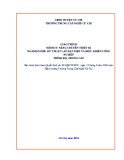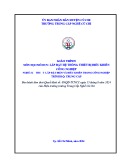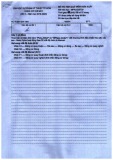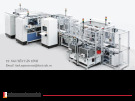
ISSN 1859-1531 - TẠP CHÍ KHOA HỌC VÀ CÔNG NGHỆ - ĐẠI HỌC ĐÀ NẴNG, VOL. 22, NO. 9A, 2024 1
DESIGN AND MANUFACTURE OF A MACHINE FOR PACKAGING
CREAMPUFF CONES INTO BOXES
THIẾT KẾ VÀ CHẾ TẠO MÁY SẮP XẾP BÁNH SU KEM VÀO HỘP
Le Hoai Nam, Dang Phuoc Vinh*
The University of Danang - University of Science and Technology, Vietnam
*Corresponding author: dpvinh@dut.udn.vn
(Received: May 07, 2024; Revised: July 08, 2024; Accepted: September 10, 2024)
Abstract
- This article presents a machine's
design,
manufacturing,
and control processes for packaging
creampuffs
into
boxes. The system includes a creampuff-dropping
module
operated
by pneumatic cylinders, a horizontal box
transposition
module
controlled by the IAI ROBO Cylinder, and
multiple
conveyors
for handling boxes and creampuffs. The
Mitsubishi
FX3G PLC acts as the main control unit, enabling efficient
system operation and managing its sequential processes
. A
timer
device
is integrated to display the duration required to pack a
set
of
three boxes. The system's integration enables
accurate
creampuff
placement within the boxes. The study
provides
valuable insights for enhancing creampuff packing systems.
Tóm
tắt - Bài báo này trình bày về việc thiết kế, chế tạo và
điều
khiển
máy sắp xếp bánh su kem vào hộp. Hệ thống này bao
gồm
mô
-đun thả bánh su kem được điều khiển bằng xi-lanh khí nén, mô
-
đun
chuyển hộp theo phương ngang được điều khiển bởi bộ
IAI
ROBO
Cylinder và hệ thống nhiều băng tải để xử lý hộp và
bánh
su
kem. Bộ điều khiển Mitsubishi FX3G PLC làm nhiệm vụ
điều
khiển
trung tâm, đảm bảo hoạt động hiệu quả và tuần tự của
hệ
thống.
Một bộ đếm thời gian được tích hợp để hiển thị thời gian
cần
thiết
để đóng gói một bộ gồm ba hộp bánh. Sự tích hợp của hệ
thống
cho
phép đặt bánh su kem vào hộp một cách chính xác. Nghiên
cứu
này
cung cấp những thông tin quý giá để nâng cao hệ thống
đóng
gói bánh su kem trong công nghiệp.
Key
words - Creampuff packing system; pneumatic
cylinders
multiple conveyors; Mitsubishi FX3G PLC.
Từ
khóa - Máy sắp xếp bánh su kem; xilanh khí nén; hệ
thống
nhiều bằng tải; Mitsubishi FX3G PLC.
1. Introduction
The global food processing and packaging industry is
rapidly expanding, particularly in Japan. While automation
has transformed many aspects of life in the Industry 4.0 era,
most companies worldwide still rely on manual labor for
food packaging. This labor-intensive process demands
high concentration and repetitive tasks, leading to accuracy
issues, low productivity, and high labor costs. Moreover,
labor shortages in countries like Japan and Taiwan
necessitate hiring foreign workers simply to place pre-
prepared food into boxes. To address these challenges,
improve working conditions, and eliminate the drudgeries
of manual labor, businesses must automate their
production lines.
Consumer demand for eco-friendly products and the
rise of bio-based materials are transforming cosmetics
packaging. Researchers are developing sustainable,
biodegradable bioplastics that meet strict cosmetic
preservation requirements. Promising options like
polylactic acid and polysaccharides are showing potential,
with both rigid and flexible packaging solutions already
available. Continued research and collaboration will ensure
a greener cosmetic industry [1]. Plastic packaging poses a
disposal challenge, harming the environment. The study
[2] explored a new eco-friendly material design: cellulose
coated with specific wax molecules. Simulations suggest
this material, named Adulose, offers excellent strength
(like polyethylene) and water resistance (over 150° contact
angle). The biopolymer market reached US$ 35.9 billion in
2018, 51% of which was used in the food packaging
industry [3]. Recently, various packaging containers and
durable products using bioplastics have been actively
developed [4]-[7].
In recent years, the packaging industry has witnessed
significant advancements in automated packaging systems.
One particular area of interest is the packaging of Japanese
cream puffs, a popular and delicate pastry known as "bánh
su kem" in Vietnamese. The efficient and precise
packaging of these delicate desserts poses a unique
challenge due to their fragile nature and the need to
maintain their freshness and visual appeal. Therefore, the
development of a reliable and efficient packaging machine
for Japanese cream puffs is of great importance. This
article aims to explore the design considerations,
operational challenges, and potential solutions in creating
a specialized packaging system that can handle the delicate
nature of these cream puffs, ensuring their quality and
extending their shelf life.
Figure 1. Dimensional Requirements and Cream Puff
Arrangement (Image provided by Maruyasu Kikai Company)
The manual arrangement of cream puffs into boxes by
workers on conveyor belts is a labor-intensive process with
low productivity. To address this issue, a novel automation

2 Le Hoai Nam, Dang Phuoc Vinh
system for cream puff packaging was designed, fabricated,
and controlled using a Mitsubishi FX3U PLC. The system
operates rapidly and precisely, eliminating human errors and
hygiene concerns. The system developed for Maruyasu Kikai,
a Japanese company, meets their specific requirements by
achieving a remarkable throughput of 120 pieces per minute
(equivalent to 0.5 seconds per piece) while ensuring the
integrity of the delicate products (see Figure 1). It
continuously feeds boxes, operates a conveyor belt for product
supply, and arranges output boxes into sets of three. Overall
system requirements are described in Figure 2, in which:
Objective:
- Design, fabricate, and control an automated system
for packaging cream puffs into boxes, meeting the
following specific requirements:
Functional requirements:
- Gently pick up creampuffs from the conveyor belt
without damaging their delicate structure.
- Accurately place six creampuffs into each box in the
specified arrangement.
- Continuously feed empty boxes into the system.
- Operate a conveyor belt to supply creampuffs to the
handling mechanism.
- Arrange output boxes into sets of three.
- Ensure creampuffs remain upright and stable within
the boxes.
Performance:
- Achieve a throughput of 120 creampuffs per minute
(0.5 seconds per cream puff).
- Packaging cycle time is 3 seconds per box translating
to 7.5 seconds for three boxes.
- Ensure cream puffs are placed within a positional
accuracy of ±10 mm in both horizontal and vertical
directions. This precision is achieved through the
controlled operation of the pneumatic cylinders and the IAI
ROBO Cylinder. The margin of error associated with the
placement process is due to the limitations of the
pneumatic system and potential variations in the
creampuffs' size and shape.
- Handle delicate products without employing grippers
or suction mechanisms.
- Allow cream puffs to be stacked within boxes.
Output Handling:
- Continuously output sets of three filled boxes.
- Implement a mechanism for box feeding and delivery.
Figure 2. Overall System Requirements (Image provided by Maruyasu Kikai company)
2. Design results and investigation
2.1. Calculation and design of the system
2.1.1. Overall system
Figure 3 illustrates the system's intricate interplay,
meticulously designed to ensure efficient and precise
pastry placement within the boxes. Pastries, having
undergone meticulous separation via the dedicated
splitting mechanism, are divided into two distinct lanes.
This segregation streamlines the subsequent processes.
Subsequently, a meticulously crafted fast conveyor belt
propels the pastries forward with a precisely controlled
acceleration profile. This acceleration ensures the pastries
reach the pastry release mechanism with the optimal
velocity for a smooth and controlled descent.
Concurrently, the box supply conveyor operates with
clockwork precision, delivering empty boxes to a
designated translational mechanism. This mechanism,
powered by a robust ROBO Cylinder, meticulously
maneuvers the boxes. As the pastries are strategically
released from the upper section of the system, the lower
translational mechanism comes into play. With remarkable
efficiency, it repositions empty boxes to the precise
"pastry-catching" position, ensuring a seamless transition.
Once a box has been meticulously filled with its designated
quota of six pastries, the translational mechanism
seamlessly transports the filled box to a dedicated roller
system. This meticulously designed roller system
facilitates the smooth and controlled transfer of the filled
box onto the conveyor belt for onward transportation. The
meticulous design of each component, coupled with their
precisely orchestrated interplay, underscores the system's
efficiency and precision in ensuring the delicate pastries
reach their final destination flawlessly.
Figure 4 presents a comprehensive 3D drawing of the
system. The meticulously designed conveyor belts,
instrumental in transporting the pastries, are prominently
displayed. The pastry splitting mechanism, responsible for
the precise division of the pastries into designated lanes, is
showcased in its entirety. Additionally, the intricate details
of the pastry release mechanism, ensuring the controlled
descent of the pastries into the waiting boxes, are clearly
visible. Finally, the critical box feeding and positioning
mechanism, responsible for the timely delivery and precise

ISSN 1859-1531 - TẠP CHÍ KHOA HỌC VÀ CÔNG NGHỆ - ĐẠI HỌC ĐÀ NẴNG, VOL. 22, NO. 9A, 2024 3
placement of empty boxes, is brought to light. By delving
deeper into this comprehensive 3D model, a profound
understanding of the system's functionality and the
meticulous design considerations behind each component
can be readily grasped. The subsequent sections of this
paper will delve into a detailed exploration of these key
components, elucidating their individual functionalities
and how they synergistically contribute to the system's
overall efficiency and precision.
Figure 3. Overall diagram of the system
Figure 4. 3D drawing of the system
2.1.2. Design of splitting mechanism
Driven by the paramount objective of achieving a
production rate of 0.5 seconds per pastry (translating to 3
seconds per box), the authors opted for a self-conceived
and meticulously designed pastry-splitting mechanism.
This ingenious solution not only streamlines the overall
system but also strategically allocates additional
processing time for subsequent stages. By implementing
this novel mechanism, the authors prioritized both
efficiency and flexibility.
The core function of the pastry splitting mechanism lies
in its ability to adeptly divide the incoming stream of
pastries into two distinct lanes. Each lane is meticulously
outfitted with a pair of strategically positioned, alternating
pastry wheels (as showcased in Figure 5). This innovative
design ensures a gentle yet effective separation process,
safeguarding the integrity of the delicate pastries. The
alternating nature of the wheels further optimizes the
workflow by continuously directing pastries towards their
designated lanes without interruptions. This ingenious
mechanism exemplifies the authors' commitment to
achieving optimal efficiency while prioritizing the delicate
nature of the pastries.
Figure 6 ventures deeper into the intricate workings of
the self-conceived pastry-splitting mechanism. This
ingenious design serves a multifaceted purpose. Primarily,
it adeptly divides the incoming stream of pastries into two
distinct lanes, facilitating their orderly arrangement for
subsequent processes. Additionally, this strategic
separation strategically allocates valuable processing time,
allowing for a seamless transition to the following stages
of the system.
Figure 5. Cake splitting method
The core of this mechanism lies in a pair of
meticulously designed adjustable flaps. These strategically
positioned flaps, directly mounted on the conveyor belt
through a network of shafts and bearings, possess the
remarkable ability to rotate, gently guiding the pastries into
their designated lanes. This guidance system is
meticulously orchestrated by a pneumatic cylinder,
ensuring precise and controlled operation.
The particular selection of materials further
underscores the authors' commitment to both functionality
and durability. The individual components of the
mechanism are meticulously crafted using cutting-edge 3D
printing technology. PETG plastic, meticulously chosen
for its superior properties, serves as the building block for
this innovative design. Compared to its commonly used
counterparts, such as ABS, PLA, and PET, PETG offers a
distinct advantage: its exceptional hardness, heat
resistance, and overall durability. This material selection
ensures the mechanism can withstand the rigors of
continuous operation within the production environment.
Finally, the individual components are seamlessly
interconnected using meticulously designed hinge joints,
further enhancing the overall efficiency and long-term
reliability of the pastry splitting mechanism.
Figure 6. 3D drawing of the splitting mechanism
2.1.3. High-speed conveyor and cake-dropping mechanism
The system's heart lies in the seamless interplay
between the high-speed conveyor and the inertia-based
depositor. The conveyor, meticulously crafted from robust
steel, prioritizes structural rigidity over lighter alternatives
like aluminum or 3D-printed components. This ensures
unwavering stability even during high-speed operation,
Box
ROBO
Cylinder
Box supply
conveyor
Box
Box
Cake
Fast conveyor
Dropping
mechanism
Slipping
mechanism
Cake supply conveyor
Box transportation
conveyor Roller system
Box
collection
1
7
6
2
3
4
5
Movement direction
Before splitting mechanism After splitting mechanism
Creampuffs

4 Le Hoai Nam, Dang Phuoc Vinh
guaranteeing precise pastry placement within the trays. To
further optimize performance, strategically positioned
rollers minimize gaps between the conveyor belts,
preventing product jams and misalignment. An additional
support roller, ingeniously placed underneath the belt,
serves a dual purpose: it enhances the pulling angle for
efficient pastry transfer and reduces the motor torque
required, leading to more energy-efficient operation.
The inertia-based depositor takes center stage when it
comes to handling the delicate cream puffs.
Understanding the client's need to avoid gripping or
suction mechanisms that could damage the pastries, the
authors implemented a clever solution inspired by the
principle of inertia. This mechanism utilizes a high-speed,
dual-cylinder controlled sliding tray. The precise control
ensures the pastries descend in a perfectly vertical and
stable manner, eliminating any potential for rotation that
could damage their delicate form. Furthermore,
innovative carbon tube rollers have been incorporated to
minimize friction between the pastries and the sliding
tray. These meticulously chosen rollers, with their low-
friction properties, further safeguard the pastries during
their descent.
Figure 7. 3D drawing of high-speed conveyor and cake -
dropping mechanism
Following their division in the front mechanism, the
pastries embark on their journey along the precisely
controlled high-speed conveyor. They are deposited
sequentially into the waiting sliding trays, meticulously
positioned for optimal placement. Subsequently, robust
pneumatic cylinders, strategically mounted above the
conveyor belt, gently push the synchronized sliding trays
forward. This controlled motion ensures the pastries touch
the designated stopper wall, triggering their release. The
pastries then effortlessly fall into the waiting boxes
positioned directly below. Finally, roller sets thoughtfully
integrated into the design of the sliding trays guarantee the
pastries are inserted deep within the trays for optimal
positioning within the boxes.
This accurately arranged interplay between the high-speed
conveyor and the inertia-based depositor ensures the delicate
pastries are handled with care and precision throughout the
entire placement process. For a comprehensive visual
representation of these ingenious mechanisms, a detailed 3D
drawing is showed in Figure 7 and Figure 8. The sequence of
cakes being fed into the box through the cake release
mechanism is illustrated in Figure 9.
Figure 8. Photo of cake-dropping mechanism
Figure 9. The sequence of cakes being fed into the box
Figure 10 explores deeper into the intricate workings of
the box transport unit. This designed mechanism plays an
important role in the system's efficiency, ensuring a
seamless transition from pastry placement to box filling
and transportation. Its primary function is twofold: firstly,
to deliver empty boxes to the designated "pastry-catching"
position, and secondly, to initiate the release of filled boxes
(containing a complete set of six pastries) onto a waiting
roller system. Note that the creampuff dropping module
and the horizontal box transposition module is the most
intricate components of the system. These areas present the
greatest opportunity for simplification. For example, the
integration of more advanced sensors or a more efficient
control algorithm could enhance the system's overall
efficiency and maintainability.
Figure 10. 3D design of a box transportation unit
To achieve this with both speed and precision,
paramount for maintaining an aesthetically pleasing final
product, the unit prioritizes robustness and stability. This is
reflected in its construction – the entire system is fabricated
from high-strength steel plates, firmly secured onto a
sturdy base platform. This design ensures the unit can
Step 1 Step 2 Step 3
Box in
Box out
Box out

ISSN 1859-1531 - TẠP CHÍ KHOA HỌC VÀ CÔNG NGHỆ - ĐẠI HỌC ĐÀ NẴNG, VOL. 22, NO. 9A, 2024 5
withstand the rigors of continuous operation while
maintaining the precise positioning necessary for efficient
box handling.
2.1.4. Roller conveyor
After the pusher pushes the box out of the working
position, the box is directed onto a roller system and slides
down. The rollers are made of aluminum tubes with a
diameter of 8 mm, and the rotating shafts are carbon tubes
with a diameter of 2 mm. They are secured in place by two
3D-printed plastic bars (see Figure 11). This system is
mounted on elevated steel stands that are formed through a
stamping process. The stands are designed with a slope of
more than 10 degrees, allowing the boxes to slide down
smoothly without getting stuck.
Figure 11. Roller conveyor for transporting boxes of pastries
2.2. Control system
The control system architecture of the entire system is
shown in Figure 12. The central controller, Mitsubishi
FX3G-60M PLC, plays an important in governing the
system's operation. It controls the pneumatic cylinders
through 5/2 pneumatic valves, which are responsible for
managing the cake dividing mechanism. It also utilizes 5/2
valves to control the retractable trays of the cake-dropping
mechanism, and relays to regulate the conveyor motors.
Figure 12. Diagram of control system
In addition, the PLC handles the Robo Cylinder
actuator with the help of the CC-Link FX3U-16CCL-M
module. This allows the adjustment of the box position and
the ejection of boxes once they are filled with six cakes.
Refining the control algorithm is directly linked to
minimizing machine vibration. By optimizing the control
algorithm, it is possible to reduce disruptive oscillations
and noise during operation, leading to smoother machine
performance. Furthermore, the PLC establishes
communication with the Arduino controller to display the
system's productivity on the screen..
2.3. Finished machine and Resutls
Figure 13 and Figure 14 show the completed creampuff
sorting and packaging machine. Despite its compact size
(as evidenced by the figures), the machine boasts
impressive capabilities. This compact design facilitates
seamless integration into production lines with limited
space availability. Additionally, the machine's competitive
cost structure makes it an attractive investment for
businesses seeking to optimize their operations without
sacrificing quality.
Figure 13. Photo of the finished system
Figure 14. Photo of the finished system
The most important of the system is a smart control
system that precisely manages each step of the sorting and
packaging process. This system ensures precise handling
of the delicate cream puffs, guiding them gently through
the machine for meticulous arrangement and secure
packaging. A lot of experimental tests has confirmed the
machine's consistent delivery of flawless performance,
consistently meeting the stringent quality standards
demanded within the industry. Furthermore, the machine
demonstrates unwavering efficiency in handling large
volumes of creampuffs, making it a valuable asset for high-
throughput bakery operations.
Figure 15 depicts the four experiments showcasing the
final product, which features cream puffs flawlessly
arranged within the boxes. Extensive testing has confirmed
the system's ability to consistently meet the company's
demanding requirements. Notably, the system boasts a
remarkably low failure rate, exceeding expectations with a
performance exceeding 95% reliability. This translates to
exceptional operational stability and minimal downtime,
critical factors for high-throughput bakery environments.
Controller Module Actuator
Input
Photo Sensor
Switch
7-seg LED
Cylinder
DC MotorRelay
5/2 Valve
PWM module
Arduino UNO
PLC
CC-Link
PCON-CB ROBO Cylinder












![Đề cương đề tài nghiên cứu khoa học [chuẩn nhất/mới nhất]](https://cdn.tailieu.vn/images/document/thumbnail/2025/20251117/duong297/135x160/26111763433948.jpg)













